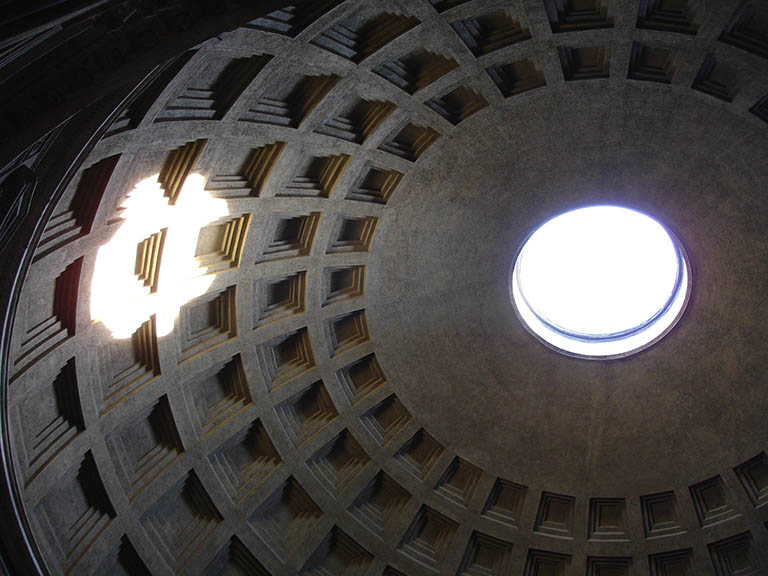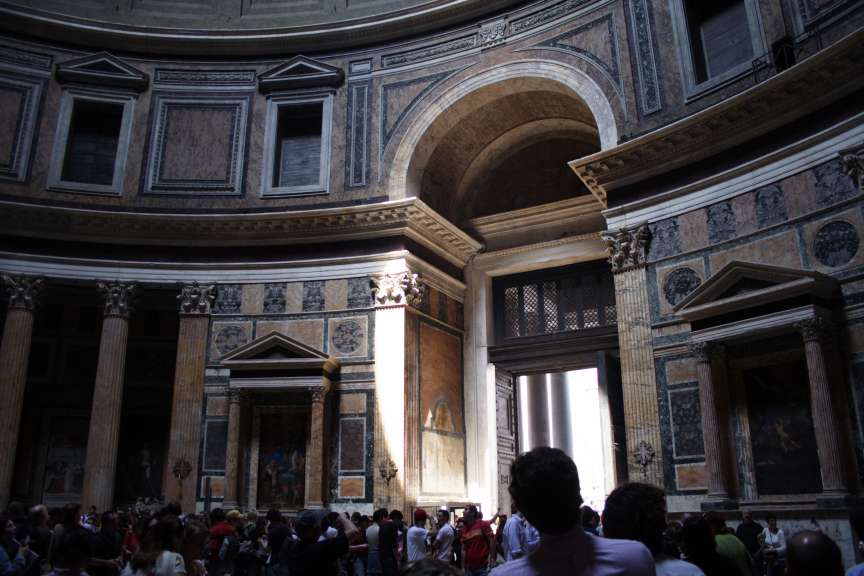
Category of Astronomical Heritage: tangible immovable
The Pantheon, Rome, Italy

Presentation
Geographical position
Piazza della Rotonda, Rome, Italy.
Location
Latitude 41° 53′ 55″ N, longitude 12° 28′ 37″ E. Elevation 15m above mean sea level.
General description
The Pantheon is the one of best-preserved buildings of the Roman period in Rome and shares with the Coliseum the title of most famous.
Brief inventory
The Pantheon as preserved today is composed of a rectangular pronaos (portico) with three lines of granite columns fronting a circular building. The latter is designed as a huge hemispherical dome (43.3m in diameter) built over a cylinder of the same diameter and as high as the radius. There is a circular opening (oculus) 8.3m wide in the top of the cupola. The wall in the interior is divided into sixteen regularly spaced sectors: the northernmost contains the entrance door while the rest contain niches and columned recesses in alternation.
The oculus provides the only source of natural light for the building, since direct sunlight can never enter through the north-facing entrance. As a consequence, the interior gives the visitor a strange impression of coldness and dark, except on sunny days when one’s attention is drawn to the huge beam of sunlight entering through the oculus.

History
The Pantheon was built by Agrippa around 27 BC under Augustus’s rule, but its present form is due to Hadrian, c. AD 128.
Cultural and symbolic dimension
The Pantheon has exerted a tremendous influence on architecture since the Renaissance; however—apart from a brief mention by Pliny and one by Cassius Dio, writing some 70 years after Hadrian, who makes a cryptic statement about the monument being the temple of all the gods—no written source tells us why the Pantheon was built or how it was used. However, there exists convincing evidence that this monument was strongly connected with the solar cycle during the course of the year, and that at least one of its main functions (if not its main purpose) was to associate the sun with the power of Rome and to reinforce the emperor’s divine right to rule.
The monument acts like a giant sundial with a dark interior, a type well known in the Roman world. During the winter months the beam illuminates only the vaulted dome. However, at noon on the equinoxes it just touches the base of the dome. After the spring equinox it starts descending and on the days around Apr 21 (as well as the symmetric ones in late August) the beam of sunlight fully illuminates the entrance at noon, creating a spectacular hierophany. Closer to the summer solstice, the beam passes across the floor during the middle of the day, although it never reaches the centre.
The spring equinox was connected with the apotheosis of the emperor, while Apr 21 was the traditional date of the foundation of Rome as stated, for example, by Ovid. (In Hadrian’s times the differences between the Julian Date in use and the ‘correct’ Gregorian date was still minimal.) By entering ‘with the sun’ during celebrations on this day, the emperor would succeed in ‘placing Rome among the Gods’. In this and other ways, it is likely that the Pantheon encapsulated Hadrian’s ideas about the relationship between Roman religion and power.

Authenticity and integrity
The architectural alignments giving rise to the solar phenomena in the Pantheon are unaltered since the time of Hadrian’s reconstruction. The shift in the sun’s position owing to the change in the obliquity of the ecliptic since that time is almost negligible.
Management and use
Present use
The site is open to the public, free of charge.
State of conservation
Very good.
Main threats or potential threats
No threats known.
Protection
The Pantheon is on the World Heritage List as part of the “Historic Centre of Rome” World Heritage Site (no. 91).
Archaeological / historical / heritage research
There is a substantial literature relating to the Pantheon. See the bibliography and references therein for research relating to astronomy.
Management, interpretation and outreach
The monument is the property of the Italian State. It is entrusted to the ‘Soprintendenza per i beni architettonici e paesaggistici’ of the Roman administration authority, which is responsible for its maintenance.
References
Bibliography (books and published articles)
- Oudet, J.F. (1992). ’Le Panthéon de Rome ├á la lumière de l’equinoxe‘, in Readings in Archaeoastronomy, edited by S. Iwaniszewski, pp. 25-52. Warsaw: State Archaeological Museum.
Links to external sites
- Hannah, R. and Magli, G. (2009). ’The role of the sun in the Pantheon’s design and meaning‘, http://arxiv.org/abs/0910.0128
No multimedia content published
Currently there is no multimedia content published for this case study







